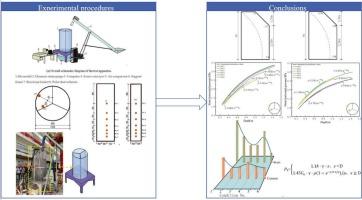Experimental study on static horizontal pressure of three-compartment silo wall and dynamic overpressure characteristics of material discharge
IF 4.6
2区 工程技术
Q2 ENGINEERING, CHEMICAL
引用次数: 0
Abstract
The three-compartment silo with a fan-shaped cross-section has caused problems in accurately calculating the depth of the silo based on the traditional height-to-diameter ratio. This paper designed a three-compartment acrylic silo model with a height of 2000 mm and a diameter of 1000 mm, and completed six different storage height feeding-settling-discharging experiments. Combining the deep and shallow silo theories in Chinese standards, this paper analyzed the distribution patterns and influencing factors of static and dynamic horizontal pressure.The criteria for classifying three-compartment silos into deep and shallow silos are provided. When the height of the silo is greater than or equal to its diameter, a three-compartment silo with a sector-shaped cross-section should be considered a deep silo design. When the height of the silo is less than its diameter, it should be considered a shallow silo design.Static horizontal pressure increases with increasing storage height, and the static pressure value of cement is higher than that of ceramic beads. The deviation between the test values and the standard deep silo calculation values is within 30 %, verifying the safety of the standard. Dynamic horizontal pressure reaches its peak at the beginning of discharge, and the overpressure coefficient of ceramic beads is significantly higher than that of cement.The study revised the horizontal pressure calculation formula based on experimental data and the classification criteria for deep and shallow warehouses, introduced correction factors of 1.1 and 1.45, and proposed a revised formula.

三室筒仓壁静水平压力及出料动超压特性试验研究
扇形截面的三室筒仓在传统的高径比基础上难以准确计算筒仓深度。本文设计了高度为2000 mm、直径为1000 mm的三室亚克力筒仓模型,完成了6次不同存储高度的进料-沉降-出料实验。结合我国标准中深筒仓和浅筒仓理论,分析了静、动水平压力的分布规律及影响因素。给出了将三室筒仓划分为深筒仓和浅筒仓的标准。当筒仓高度大于或等于筒仓直径时,截面呈扇形的三室筒仓应考虑为深筒仓设计。当筒仓的高度小于其直径时,应考虑为浅筒仓设计。静水平压力随储存高度的增加而增大,水泥静压值高于陶瓷珠静压值。试验值与标准深筒仓计算值偏差在30%以内,验证了标准的安全性。动水平压力在排放开始时达到峰值,陶瓷微珠的超压系数明显高于水泥。本研究根据实验数据,结合深库和浅库的分类标准,对水平压力计算公式进行了修正,引入了修正系数1.1和1.45,提出了修正公式。
本文章由计算机程序翻译,如有差异,请以英文原文为准。
求助全文
约1分钟内获得全文
求助全文
来源期刊

Powder Technology
工程技术-工程:化工
CiteScore
9.90
自引率
15.40%
发文量
1047
审稿时长
46 days
期刊介绍:
Powder Technology is an International Journal on the Science and Technology of Wet and Dry Particulate Systems. Powder Technology publishes papers on all aspects of the formation of particles and their characterisation and on the study of systems containing particulate solids. No limitation is imposed on the size of the particles, which may range from nanometre scale, as in pigments or aerosols, to that of mined or quarried materials. The following list of topics is not intended to be comprehensive, but rather to indicate typical subjects which fall within the scope of the journal's interests:
Formation and synthesis of particles by precipitation and other methods.
Modification of particles by agglomeration, coating, comminution and attrition.
Characterisation of the size, shape, surface area, pore structure and strength of particles and agglomerates (including the origins and effects of inter particle forces).
Packing, failure, flow and permeability of assemblies of particles.
Particle-particle interactions and suspension rheology.
Handling and processing operations such as slurry flow, fluidization, pneumatic conveying.
Interactions between particles and their environment, including delivery of particulate products to the body.
Applications of particle technology in production of pharmaceuticals, chemicals, foods, pigments, structural, and functional materials and in environmental and energy related matters.
For materials-oriented contributions we are looking for articles revealing the effect of particle/powder characteristics (size, morphology and composition, in that order) on material performance or functionality and, ideally, comparison to any industrial standard.
 求助内容:
求助内容: 应助结果提醒方式:
应助结果提醒方式:


